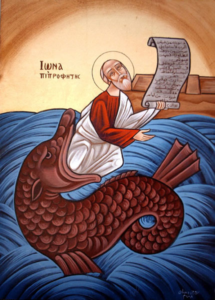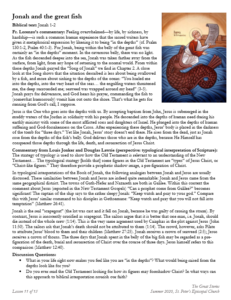
Biblical text: Jonah 1-2
Fr. Lorenzo’s commentary: Feeling overwhelmed—by life, by sickness, by hardship—is such a common human experience that the sacred writers have given it metaphorical expression by likening it to being “in the depths” (cf. Psalm 130:1-2, Psalm 40:1-3). For Jonah, being within the belly of the great fish was certainly an “in the depths” moment. In the cavernous belly, there was no light. As the fish descended deeper into the sea, Jonah was taken farther away from the surface, from light, from any hope of returning to the normal world. From within these depths Jonah prayed the “Song of Jonah” we find in Chapter 2. A close look at the Song shows that the situation described is less about being swallowed by a fish, and more about sinking to the depths of the ocean: “You hurled me into the depths, into the very heart of the seas… the engulfing waters threatened me, the deep surrounded me; seaweed was wrapped around my head” (3-5). Jonah prays for deliverance, and God hears his prayer, commanding the fish to (somewhat humorously) vomit him out onto the shore. That’s what he gets for running from God’s call, I suppose.
Jesus is the One who goes into the depths with us. By accepting baptism from John, Jesus is submerged in the muddy waters of the Jordan in solidarity with his people. He descended into the depths of human need during his earthly ministry with some of the most afflicted sons and daughters of Israel. He plunged into the depths of human suffering and God-forsakenness on the Cross. After experiencing these depths, Jesus’ body is placed in the darkness of the tomb for “three days.” Yet like Jonah, Jesus’ story doesn’t end there. He rises from the dead, just as Jonah rose from the depths of the fish’s belly. God delivers those who are in the depths, because He Himself has conquered those depths through the life, death, and resurrection of Jesus Christ.
Commentary from Louis Jonker and Douglas Lawrie (perspective: typological interpretation of Scripture):
The strategy of typology is used to show how the Old Testament is relevant to an understanding of the New Testament… The typological strategy [holds that] some figures in the Old Testament are “types” of Jesus Christ, or “Christ-like figures.” They therefore provide a prophetic shadow image, a pre-figuration of Christ.
In typological interpretations of the Book of Jonah, the following analogies between Jonah and Jesus are usually discussed. These similarities between Jonah and Jesus are indeed quite remarkable: Jonah and Jesus came from the same geographical district. The towns of Gath-Hefer and Nazareth are both in Galilee. Within this context the comment about Jesus (reported in the New Testament Gospels) “Can a prophet come from Galilee?” becomes significant! The captain of the ship says to the rather sleepy Jonah: “Keep watch and pray to your god.” Compare this with Jesus’ similar command to his disciples in Gethsemane: “Keep watch and pray that you will not fall into temptation” (Matthew 26:41).
Jonah is the real “scapegoat” (the lot was cast and it fell on Jonah, because he was guilty of causing the storm). By contrast, Jesus is innocently crucified as scapegoat. The sailors argue that it is better that one man, i.e. Jonah, should die instead of the whole crew (1:14). This is the very same argument used by Caiaphas in the plot against Jesus (John 11:50). The sailors ask that Jonah’s death should not be attributed to them (1:14). The crowd, however, asks Pilate to attribute Jesus’ blood to them and their children (Matthew 27:25). Jonah receives a crown of seaweed (2:5); Jesus receives a crown of thorns. The three days that Jonah spent in the belly of the big fish may be regarded as a pre-figuration of the death, burial and resurrection of Christ over the course of three days. Jesus himself refers to this comparison (Matthew 12:40).
Discussion Questions:
- What in your life right now makes you feel like you are “in the depths”? What would being raised from the depths look like for you?
- Do you ever read the Old Testament looking for how its figures may foreshadow Christ? In what ways can this approach to biblical interpretation nourish our faith?



Comments are closed.